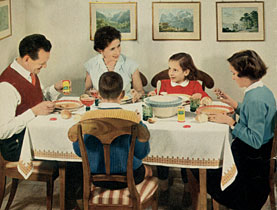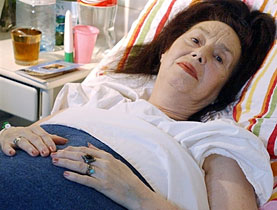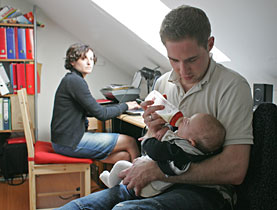Family stays healthy despite growing demands

Families are thriving in Switzerland, although they are confronted with ever increasing demands, research presented in Zurich has found.
But the exhibition at the Swiss National Museum demonstrates that families have always had to adapt to change. Patchwork families and late marriages are not new concepts.
“Families – the constant is change” opens on Friday – a day after the International Day of Families – and focuses on the social and cultural development of the middle class family in Switzerland since 1750.
It shows that although families, such as that of farmer’s son and diarist Johann Ulrich Bräker, were very different in the 18th century – they included the servants – there were some similarities to today.
Like now, men like Bräker married late, but for different reasons – they had to ensure the upkeep of the whole family.
Patchwork families were not uncommon as women died in childbirth and men married again. In Bräker’s case, after his father’s death he took in his four siblings.
But there was a key difference. “Until the 19th century a young couple did not focus so much on love but on economic motives for marriage,” museum director Andreas Spillmann told swissinfo.
Industrialisation brought with it the separation of work and home and marriage for love, shown by the prosperous Ramuz family from Lausanne. One of the sons was writer Charles-Ferdinand Ramuz.
This was a time of idealisation of the family, said Spillmann. On display is a finely worked pram, and decorated plates point to a mother’s virtues of being caring, loving – and quiet.
Nuclear family
By 1950 the nuclear family had arrived: mother, father and three children, as personified by the Hürlimanns from Zug. Father Hans sat on the Swiss government. Wife Marie is shown in photos perfectly coiffed at his side.
The economy was flourishing, the welfare state working, and people married young. There was enough money for leisure activities as well.
But by 1980 these days were over, according to the museum. “For a lot of families it’s no longer possible to have just one parent earning the money and then we also have women’s emancipation,” said Spillmann.
Nowadays there is much speculation in Switzerland that the family is in decline. As pointed out in the display, the divorce rate stood at 52.7 per cent in 2006 (compared with 11 per cent in 1964) and the number of births stood at 73,713 (1964: 111,167).
However, this is not the view of psychologist Pasqualina Perrig-Chiello.
The Bern University professor chaired the five-year National Research Programme “Children, Adolescents and Generational Relations in a Changing Society”, the first study of its kind in Switzerland. Some of its results – it only concluded a few months ago – are on show at the exhibition.
“Normal model”
“The data shows that in the past two decades there is something like a ‘normal model’ of the family, which is a married couple with their children,” Perrig-Chiello told swissinfo. “Four-fifths of all children under 18 in Switzerland live in such a family.”
There is also no evidence of an “intergenerational war” between the older and younger generations, she said.
The study highlighted some problems, such as paradox childrearing – when parents have high demands of their children but don’t give them enough support – which can lead to physical and mental problems among young people. This affects one in seven children, said Perrig-Chiello.
Educational opportunities and social mobility were also found to still be strongly dependent on social and economic background – a surprising result for rich Switzerland, she added.
Only one in ten children of low-income families make it into the top secondary schools, compared with 60 per cent of middle and upper income children, it was found.
Overall, the demands on families have steadily increased, said the psychologist. It is taken for granted that family units are financially, morally and socially responsible for their members.
“At the same time we don’t have great efforts on the level of infrastructure to help families do this job,” said Perrig-Chiello, pointing to the estimated 50,000 shortfall in crèche places.
The professor nevertheless believes that the outlook for families is good, bound as they are by love, sharing and the need to belong.
Spillmann agrees. “Families are an anthropological constant and will exist as long as human beings exist.”
swissinfo, Isobel Leybold-Johnson in Zurich
Families – the constant is change runs at the National Museum in Zurich until September 14.
It is organised jointly with the National Research Programme 52 on Childhood, Youth and Intergenerational Relations in a Changing Society, which lasted from 2003-08.
It covers the development of the family in Switzerland from the perspective of social and cultural history since 1750.
Opening hours: Tuesday-Sunday 10am-5pm, Thursday to 7pm. Monday closed, open on holidays. Events are also organised around the exhibition.

In compliance with the JTI standards
More: SWI swissinfo.ch certified by the Journalism Trust Initiative













You can find an overview of ongoing debates with our journalists here . Please join us!
If you want to start a conversation about a topic raised in this article or want to report factual errors, email us at english@swissinfo.ch.